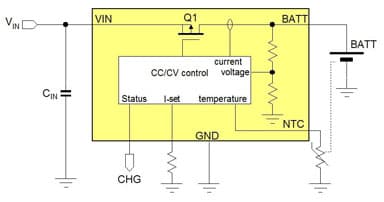Selecting a Battery Charger IC
Battery Charger ICs
Battery Charger ICs can be used to provide the correct charge current and voltage for the specific battery cell in your application.
Most battery chargers are designed for Li-Ion batteries since these most popular in hand-held equipment. The battery charger will measure battery charge current and battery voltage, and controls the pass MOSFET in such a way that the charge current follows the required battery charge operation modes: pre-conditioning - constant current - constant voltage - current cut-off.
The maximum charge current can be programmed by an external resistor, and an NTC coupled to the battery will send the battery temperature information to the charger. Charge status pins will signal the charge condition.
Most linear chargers for single cell Li-Ion batteries are fed by 5V supply, and are normally used for charge currents up to 1A, suitable for battery cells up to 1Ah.
To charge larger capacity cells, higher charge currents are needed. In this case switching chargers (Buck topology) must be selected. Some battery chargers contain power path control, which allows the system to be run from either the adapter or the battery. Battery chargers can be selected on single/dual input, fixed/adjustable current, with/without NTC sense, adapter input current limit, and Auto Power Path Management.
You might be interested in...
- Power Management Components for Lithium-Ion Battery Powered Applications
- Parametric Search: Get your design started in no time!
